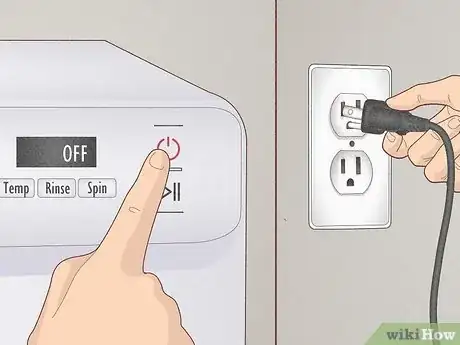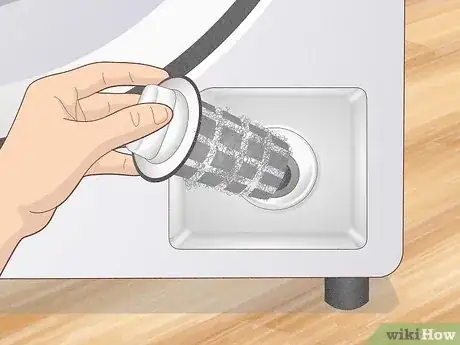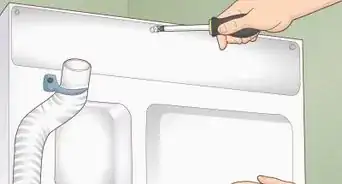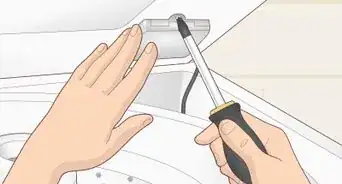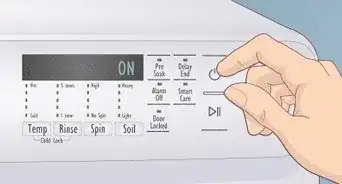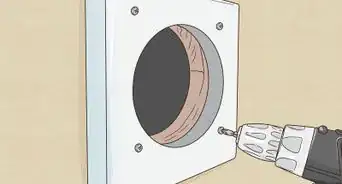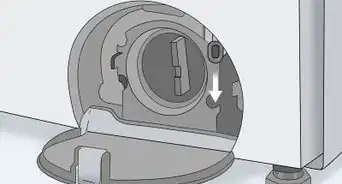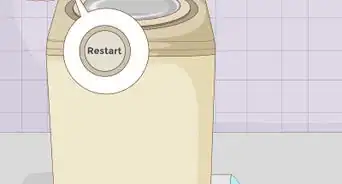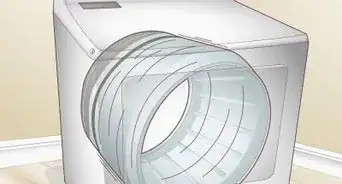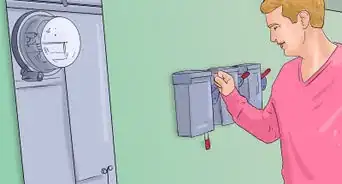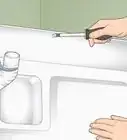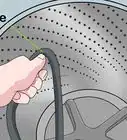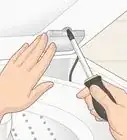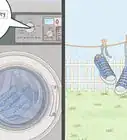This article was co-authored by Ashley Matuska and by wikiHow staff writer, Devin McSween. Ashley Matuska is a Professional Cleaner at the Founder and Owner of Dashing Maids in Denver, Colorado. Ashley has over seven years of experience in the cleaning industry. She and her team specialize in offering sustainable deep cleaning and maintenance cleaning services.
There are 9 references cited in this article, which can be found at the bottom of the page.
This article has been viewed 313,530 times.
If your clothes are still sopping wet after your washing machine’s final spin, a dirty filter might be the culprit. Luckily, cleaning your washing machine filter is super quick and easy. In this article, we’ll show you how to find your filter in your front or top-loading machine, as well as how to remove the lint and debris on it. If you’re ready to get cleaning, read on!
Things You Should Know
- Unplug your machine and find the filter. For front-loading machines, check the outside and bottom right corner. On top-loading machines, look under the agitator.
- Pull out the filter and brush off any lint with a clean paper towel.
- Remove the screen in the filter and soak it in hot water for 10 minutes.
- Clean your washing machine’s filter every 3 months.
Steps
Locating and Removing the Filter
-
1Turn off and unplug your washing machine. Before locating and removing your filter, it is important to disable your machine. Start by turning all of the buttons to a neutral position or hit the “Off” button, if your machine has one. Then, turn off the power from the wall socket and unplug your washer.[1]
- Leave the plug in a safe location where it cannot get wet during the cleaning process.
- Put down some old towels in front of your washer to soak up any water stuck inside the filter.
-
2Find your washing machine filter. For front-loading machines, the filter is usually in the bottom right corner on the outside of the washer. If you have a top-loading machine with a self-cleaning filter, look under the agitator. For older top-loading washers, check for your filter in the bottom right-hand corner of the machine.[2]
- The agitator is the device located directly in the center of the machine that rotates back and forth during the wash cycle.
- Self-cleaning filters still need to be cleaned every 3 to 4 months.
- If your filter is in the bottom right-hand corner of the machine, it typically has a rectangular or circular cover over it.
- If you are unable to locate your filter, consult your machine’s manual.
Advertisement -
3Remove the cover of your filter. Simply grip the cover and pull it away from your machine to take it off. If your machine’s cover is childproofed, use a thin object, such as a screwdriver, to pry the cover off. Then, turn the cover counter-clockwise until it comes off completely.[3]
- For top-loading washers with the filter under the agitator: remove the agitator first. Take the cap off of the agitator and put your hand inside the shaft until you feel a wing-nut screw. Twist the screw counter-clockwise until it comes out, then lift the agitator off. With the agitator removed, lift the filter cover out of position.[4]
-
4Take out your filter. Just pull the filter out of your machine once the cover is off. If the filter gets stuck, wiggle and move it around as much as you can. This helps to loosen up any lint or detergent that might cause it to stick.[5]
- As you remove your filter, you’ll likely see a layer of wet lint mixed with detergent.
- In some washers, the draining hose is located directly in front of the filter. If the drain hose blocks the filter from coming out, remove it and then pull out the filter.
Cleaning Your Filter
-
1Use a paper towel to remove any lint from the filter. A build-up of excess detergent mixed with lint leaves behind residue on your filter. To remove it, use a clean paper towel to wipe the screen.[6]
- If the layer of lint is on the thicker side, use a small brush, such as an old toothbrush, to remove the debris.
-
2Remove the screen from the filter and soak it in hot water for 10 minutes. If your lint screen is removable, take it off and place it in a bowl of hot tap water. Soaking it removes any lingering lint, fabric softener, or detergent that can’t be cleaned with a paper towel.[7]
- If you cannot remove the screen from the filter, hold the filter under hot running water until all of the residue is removed.[8]
-
3Inspect the inside of the machine for excess lint. Before replacing the filter, check the inside of the machine for any loose lint. If there is lint in the drum of the washer, use a paper towel to remove it or scrub it with a wet sponge.[9]
- If your filter is in the bottom right-hand corner of the machine, inspect and remove any lint from the drainage hose. The hose is usually located in front of where you removed the filter, or directly next to it.
-
4Replace the filter and the outer cover. Once your filter is free from all residue, put it back in the machine. There’s no need to let it dry, as it gets wet when you use your washer. If you removed the drainage hose, put it back before securing the cover.[10]
- If your filter is under the agitator, set the filter back in its spot and secure the cap. Place the agitator over the filter and secure the wing-nut and the cap of the agitator.
-
5Run an empty washer cycle to test for leaks. Before resuming your regular washes, check that you placed the filter and cover back on correctly. To do that, simply run your washer through a small cycle. Just keep your washer empty while you run the cycle. If your washer is leaking, the filter is not on correctly.[11]
- If you had to remove the draining hose, check that it is properly secured, as the leak could also be coming from there.
Prolonging the Life of Your Filter
-
1Clean your filter at least 4 times a year. It is recommended that you clean your filter every 3 months. The filter collects hair, coins, and tissues, so it is important to clean it regularly. If you don’t have time to do a thorough clean every 3 months, regularly check your filter for any possible build up.[12]
- Cleaning your filter regularly also prolongs the life of your washing machine.
- A dirty filter can also cause your washing machine to start smelling.[13]
-
2Identify problems right when they occur. Pay attention to signs that your filter needs to be cleaned. Being proactive about your washer’s problems keeps it in tip-top shape and prevents you from dealing with a washer that decides to stop working mid-cycle.[14]
- Excessive vibrations, wet clothes after the final spin, or problems with the water draining are common signs that your filter is clogged.
-
3Wipe the door seal out after every use. Even if you clean your filter regularly, anything stuck in the door seal can get trapped in your filter. This residue might clog your filter, depending on how long it’s been since you cleaned the seal. This often makes the filter harder to clean and can reduce its life. So, to prevent clogs, use a rag to wipe the exposed area of the door seal after each wash.[15]
- The door seal is a rubber piece that is located right inside the washer door. It is the part that keeps water from escaping when the washer is full.
Community Q&A
-
QuestionWhere is my filter on a top-loading washing machine?
 wikiHow Staff EditorThis answer was written by one of our trained team of researchers who validated it for accuracy and comprehensiveness.
wikiHow Staff EditorThis answer was written by one of our trained team of researchers who validated it for accuracy and comprehensiveness.
Staff Answer wikiHow Staff EditorStaff AnswerThe filter on most top-loading machines is located under the agitator, or the component in the middle of your machine's drum. If your washing machine is a newer model, it might not have a filter at all.
wikiHow Staff EditorStaff AnswerThe filter on most top-loading machines is located under the agitator, or the component in the middle of your machine's drum. If your washing machine is a newer model, it might not have a filter at all. -
QuestionCan a top-loading washing machine dump lint from the filter into the drum?
 wikiHow Staff EditorThis answer was written by one of our trained team of researchers who validated it for accuracy and comprehensiveness.
wikiHow Staff EditorThis answer was written by one of our trained team of researchers who validated it for accuracy and comprehensiveness.
Staff Answer wikiHow Staff EditorStaff AnswerYes, usually if your washing machine's filter is clogged. This often causes excess lint to remain in the drum. You might notice that your clothes are covered with lint when you take them out of the washer.
wikiHow Staff EditorStaff AnswerYes, usually if your washing machine's filter is clogged. This often causes excess lint to remain in the drum. You might notice that your clothes are covered with lint when you take them out of the washer. -
QuestionI have an LG dryer and my clothes come out with little "pills" on them. I either have to shave the clothes or throw them out. What causes this?
 wikiHow Staff EditorThis answer was written by one of our trained team of researchers who validated it for accuracy and comprehensiveness.
wikiHow Staff EditorThis answer was written by one of our trained team of researchers who validated it for accuracy and comprehensiveness.
Staff Answer wikiHow Staff EditorStaff AnswerMost pilling is just the result of regular wear and tear. As you wash, dry, and wear your clothes, the fabric tends to loosen, break, and roll into little balls. To help prevent pilling, wash clothes of similar fabrics together and hang them up to dry.
wikiHow Staff EditorStaff AnswerMost pilling is just the result of regular wear and tear. As you wash, dry, and wear your clothes, the fabric tends to loosen, break, and roll into little balls. To help prevent pilling, wash clothes of similar fabrics together and hang them up to dry.
References
- ↑ https://www.cleanipedia.com/ph/in-the-home/how-to-clean-a-top-load-washing-machine.html
- ↑ https://www.angi.com/articles/clean-washing-machine-filter.htm
- ↑ https://www.samsung.com/ie/support/home-appliances/how-do-i-clean-the-debris-filter-in-my-front-loading-samsung-washing-machine/
- ↑ https://www.laundry-alternative.com/agitator-washer/
- ↑ https://www.readersdigest.ca/home-garden/cleaning/wheres-the-filter-on-a-washing-machine/
- ↑ https://www.angi.com/articles/clean-washing-machine-filter.htm
- ↑ https://www.readersdigest.ca/home-garden/cleaning/wheres-the-filter-on-a-washing-machine/
- ↑ https://producthelp.fisherpaykel.com/us/Wash/Front_Loaders/WashSmart/WH2424P1/User_Guide_WH2424P1/13_caring_for_your_washer
- ↑ https://producthelp.fisherpaykel.com/us/Wash/Front_Loaders/WashSmart/WH2424P1/User_Guide_WH2424P1/13_caring_for_your_washer
- ↑ https://www.samsung.com/ie/support/home-appliances/how-do-i-clean-the-debris-filter-in-my-front-loading-samsung-washing-machine/
- ↑ https://www.angi.com/articles/clean-washing-machine-filter.htm
- ↑ https://www.angi.com/articles/clean-washing-machine-filter.htm
- ↑ Ashley Matuska. Professional Cleaner. Expert Interview. 15 April 2019.
- ↑ https://www.treehugger.com/cleaning-organizing/8-tips-maintaining-front-load-washing-machines.html
- ↑ https://www.cnet.com/how-to/give-your-washing-machine-a-deep-clean-to-remove-mildew-and-pocket-junk/
About This Article
Before cleaning the filter on your washing machine, power the machine down and unplug it. Lay some old towels down on the floor in front of the machine in case any water leaks out when you remove the filter. If you have a front-loading or older top-loading washer, the filter is usually located in the lower right corner of the machine. However, many newer top-loading models have a filter inside the machine, underneath the agitator. Once you locate the filter, take the cover off. You may need to pry it off with a screwdriver. Then, grab the handle on the filter and pull it out. Wipe any excess lint and residue off the filter with a paper towel, then remove the screen from the filter and soak it in hot water for 10 minutes. Look inside the washing machine for any loose lint and wipe it out before sliding the filter back into place and replacing the cover. Run the washing machine on a regular cycle without any laundry in it and check for leaks to make sure that you put the filter back in correctly. To learn how to prolong the life of your filter, keep reading!
